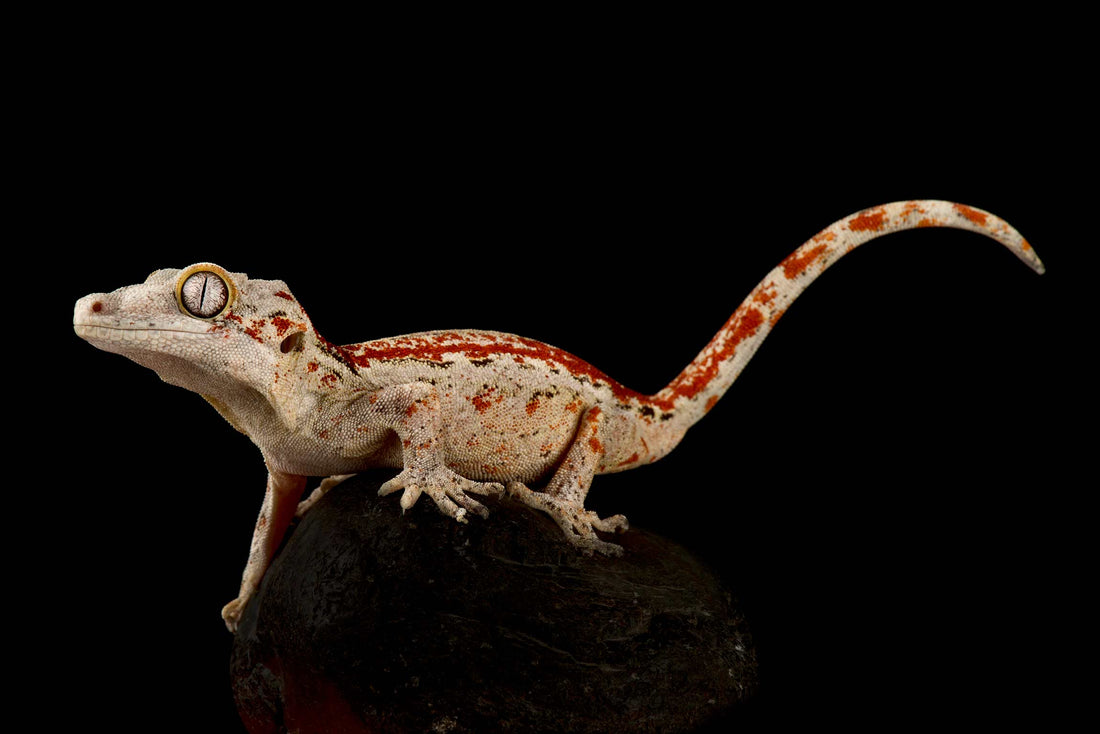Natural Habitat
Gargoyle geckos are only found on the island of New Caledonia in the South Pacific Ocean. The climate in New Caledonia is semi-tropical which is very similar to the conditions found in most of our homes and apartments. This makes the gargoyle gecko one of the easiest species to maintain correctly indoors. gargoyle geckos are primarily arboreal, spending most of their time above the ground in branches. Your habitat should be structured in such a way so that your gecko has many opportunities for climbing and utilizing the entire volume of its habitat. Live plants and many branches of varying diameter should be considered a must.
Leap Habitat Size
22”x 17”x 24” minimum. Larger sizes are even better!
Nutrition
Gargoyle geckos are omnivores, meaning they eat both animal and plant matter. A diet consisting of live insects and fruit based gecko diets will provide your gargoyle gecko with all the nutrition it needs. There are several brands of high quality gecko diet, such as Pangea and Repashy, that make excellent meals for your gecko. Feeding your gecko as wide a variety of insect prey as possible is best. Suitable feeder insects include: crickets, mealworms, superworms, dubia roaches, and silkworms. Your feeder insects should be fed with a high quality calcium rich diet to “gutload” them and make them more nutritious for your pet gecko. Feeder insects should also be dusted with a pure calcium supplement at almost every feeding. The feeders should also be dusted with a multivitamin supplement twice a month. Try to feed your gecko when it is active so it receives the benefits of the supplement powder before the insects remove the powder from themselves. The number of insects will vary greatly depending on the type of insect and the age of your gecko. In general, feed as many insects as your gecko will eat in an hour or less. Juvenile gargoyle geckos can be fed five or six times a week and adults two or three times a week. At least one of those feedings should consist of live insects. The other feedings can consist of prepared gecko diet.
Five Parameters
-
Daylight/Photoperiod
Gargoyle geckos are primarily nocturnal but do frequently spend large portions of the day exposed or partially exposed to light. They experience some seasonal variation in lighting in their natural habitat and that should be replicated in your home. We recommend that your Leap LED lighting is on for 13 hours a day in the summer, 12 hours a day in the spring and fall, and 11 hours a day in the winter.
-
UV/Photoperiod
The necessary duration of UV lighting is still being researched and UV certainly isn’t at peak levels throughout the day. At this time we recommend that the UV light is on for four to six hours a day around midday.
-
Heat
In general a “hot” side of the habitat should be provided and reach temperatures of 78-80 F. The middle of the habitat can be in the mid 70s and the “cool” side should be in the low 70s. Ideally your habitat should have two hides, or retreats, that your gecko can enter fully on either side of the habitat. One on the “hot” side and one on the “cool” side. Elevated cork tubes make excellent hides. A dedicated heat bulb is often not necessary for this species but if extra heat is needed a low wattage halogen bulb can be used as this is our best current technology at replicating the natural heating benefits of the sun. We recommend that your heat bulb should be on for approximately four hours a day around midday. Be careful when adding supplemental heat as temperatures over 85 F can be dangerous for your gargoyle gecko.
-
Water/Misting
Gargoyle geckos will primarily drink by lapping up rain or dew droplets. They will utilize a water bowl however and a small bowl of clean fresh water should also always be provided. gargoyle geckos experience a wet and a dry season in nature. For half of the year you should use your Leap misting system more frequently and for the other half of the year less so. It’s hard to approximate a rain schedule as everyone’s home conditions are different. In general a rain just before lights out and immediately after lights on is a good place to start.
-
Humidity/Fogging
Gargoyle geckos are semi-tropical animals and humidity should be kept relatively high (60-80%) for most of the day. However, an increase in humidity at dawn is natural and beneficial. A moderate, ten minute, fogging session can provide this. Monitor humidity levels so that you do not overly saturate your gecko's habitat. All visible water droplets should evaporate by midday.
Handleability/Pet metric
Gargoyle geckos are some of the best “pet” reptiles you can have! Juveniles are often flighty and wary of human interaction but adults are often extremely calm and handleable. In the beginning keep handling sessions brief and calm. Do not forcibly restrain your gecko. Allow it to climb onto your hand and then place one hand in front of the other as it crawls. Keep your gecko close to a surface like a table or the floor in case it leaves your hands. You don’t want your gecko to fall far. Remember, even a foot off the ground is a considerable height to a small gecko. gargoyle geckos are very prone to jumping so be prepared! When handling your gecko avoid touching or pinching the tail as your geck may drop its tail as a defense mechanism. A gargoyle's tail will regenerate over a period of a few months. Any handling done by children should be supervised by an adult.
Difficulty
Beginner. Gargoyle geckos are some of the hardiest and easiest to keep of all reptiles. They make an excellent first reptile. They often live 15-20 years and are relatively low maintenance.

